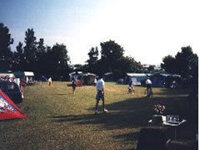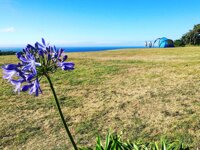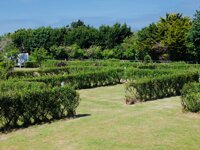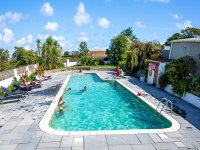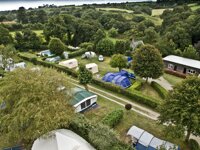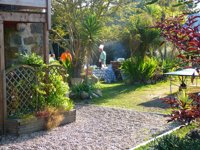Camping in the Channel Islands
10 campsites in Channel Islands
Campsite Listing Google Map
The following consent is required:
Tracking & performance, Targeting & advertising.
Channel Islands
Tucked into the Gulf of St Malo, the Channel Islands are an archipelago with lots to offer campers and caravanners. Described by Victor Hugo as ‘morsels of France fallen into the sea and gathered up by England’, they are a mix of English and French culture and heritage, with both Norman dialects and English being spoken.
The largest of the Channel Islands is Jersey, which is also the most commercial with more entertainment on offer. It has long stretches of safe beaches for swimming and water-based activities such as windsurfing and banana rides. Caravans and campers are allowed on Jersey but with a number of limitations (for example, length of stay, the width and length of the unit). A permit is required, which is obtained as part of the booking procedure with the campsite of your choice. You must book in advance, but the campsite owner will advise you on all aspects of your visit.
Guernsey will suit those who prefer a quieter, more peaceful holiday. Caravans and campervans are not allowed here. Guernsey has wide, sandy beaches plus sheltered coves. The historic harbour town of St Peter Port has steep and winding cobbled streets, with plenty of shops, cafés and restaurants.
Smallest of all are Herm and Sark, the former of which is only one and a half miles long and half a mile wide. They’re authentic getaways for a camping holiday, particularly for anyone looking for a real retreat – tranquil, pretty havens in natural surroundings. No cars are permitted on either of these islands. Explore on foot, by bicycle or horse-drawn carriage
Browse through the selection to find a location for camping in the Channel Islands. You can refine your search to find your preferred destination.
About the Channel Islands
Camping options in the Channel Islands
There are several camping options on the larger populated Channel Islands of Jersey and Guernsey, with a few options if you're visiting Alderney, Herm or Sark. No camping options exist on Jethou, Brecqhou or the smaller islets.
Basic information

The Channel Islands comprise two Crown Dependencies: the Bailiwick of Jersey, the largest among them, and the Bailiwick of Guernsey, encompassing Guernsey, Alderney, Sark, and Herm. The islands are historically linked to the Duchy of Normandy, and while not part of the United Kingdom, the UK assumes responsibility for their defence and international relations.
It's important to note that "Channel Islands" is a geographical term rather than a political entity. The two bailiwicks have been administered separately since the late 13th century, each with distinct governance and legal systems.
Places of Interest

Jersey: St Helier; Jersey Zoo; Jersey war tunnels; Elizabeth Castle; German Underground Hospital in St Lawrence; Samarès Manor in St Clement; Shell Garden at St Aubin; Battle of Flowers Museum in St Ouen.
Guernsey: Castle Cornet at St Peter Port Harbour; Victor Hugo’s House; Guernsey Folk Museum; German Occupation Museum; Fort Grey Shipwreck Museum; Saumarez Park.
Sark: La Coupée; La Seigneurie, with old dovecote and gardens; Gouliet and Boutique Caves; Le Pot on Little Sark; Venus Pool; Little Sark Village.
Herm: This tiny island has beautiful, quiet, golden beaches and a little harbour village and hotel. Arrive by ferry from Guernsey for a wonderful day out.
Did you know?
- Jersey has been associated with knitting for nearly 400 years.
- The Channel Islands were the only part of the British Isles to be occupied by the Germans during the Second World War.
- Herm island is just one and a half miles long and only half a mile wide.
- Le Jerriais is the native language of Jersey, a blend of Norse and Norman French.
Bailiwick of Jersey

Capital St Helier
Currency Pound sterling (GBP) - Jersey pound (JEP)
Language(s) English, Norman (Jèrriais) and French
Time Zones WET (GMT+00)
Summer (DST) WEST (UTC+01)
Telephone Code +44
EU Member No
Schengen Area No
Tourism Websitejersey.com
Bailiwick of Guernsey

Capital St. Peter Port
Currency Pound sterling (GBP) - Guernsey pound (GGP)
Language(s) English, Guernésiais and French
Time Zones WET (GMT+00)
Summer (DST) WEST (UTC+01)
Telephone Code +44
EU Member No
Schengen Area No
Tourism Websitevisitguernsey.com
Channel Islands Shopping
Shopping in the Channel Islands, particularly in the main towns of Jersey and Guernsey, offers a diverse and enjoyable experience. Here's an overview of shopping options in the Channel Islands:
- St. Helier, Jersey: As the capital and main commercial centre of Jersey, St. Helier offers a range of shopping opportunities. King Street and Queen Street are the main shopping streets featuring high street brands, department stores, and independent boutiques. The Central Market is a bustling covered market with fresh produce, local delicacies, flowers, and crafts.
- St. Peter Port, Guernsey: The main town of Guernsey, St. Peter Port, also provides various shopping options. The High Street is lined with shops selling fashion, jewellery, cosmetics, and souvenirs. You can explore independent retailers as well as popular brands. The old market is a historic building often hosting stalls with local produce, crafts, and antiques.
- Duty-Free Shopping: Both Jersey and Guernsey are popular destinations for duty-free shopping. Many stores offer tax-free goods, including alcohol, tobacco, perfume, cosmetics, and electronics. You can find duty-free shops in the main shopping areas, as well as at the airports and ports.
- Local Products and Souvenirs: The Channel Islands are known for their local products and souvenirs. Look out for unique items such as local pottery, jewellery made from local materials, traditional knitwear, and food specialities like local honey, jams, and cheeses. There are also numerous gift shops where you can find souvenirs representing the islands' culture and heritage.
- Markets and Events: The Channel Islands host regular markets and events where you can discover local crafts, food, and products. Keep an eye out for farmers' markets, arts and crafts markets, and seasonal events that feature local vendors and artisans.
Remember to check the opening hours of stores, as they may vary, particularly on Sundays and public holidays.
Channel Islands Money
It's worth noting that Jersey and Guernsey have their own currencies (Jersey pound and Guernsey pound), equal to the British pound sterling. Credit and debit cards are widely accepted, but having some cash on hand is always handy, especially for smaller shops and markets.
Channel Islands Public Holidays
- New Year's Day - 1st January
- Liberation Day - 9th May (commemorating the end of the German occupation during World War II)
- Spring Bank Holiday - Last Monday in May
- Summer Bank Holiday - Last Monday in August
- Christmas Day - 25th December
- Boxing Day - 26th December
These are the main public holidays in the Channel Islands, but there may be additional local holidays or events specific to each island. It's always a good idea to confirm with local sources for the most up-to-date and accurate information regarding public holidays.
Driving in the Channel Islands
Driving in the Channel Islands follows similar rules and regulations to driving in the United Kingdom:
- Driving Side: Like the UK, driving is on the left-hand side of the road in the Channel Islands.
- Driving License: You can drive in the Channel Islands if you hold a full UK license. Other travellers may require an International Driving Permit (IDP). Check if your country's driving license is accepted in the Channel Islands.
- Speed Limits: The speed limits in the Channel Islands are as follows:
-
- Guernsey - The maximum speed limit is 35mph (56 kph). Lower speed limits apply in some areas. In and around the town, the speed limit is 25mph (40 kph).
- Jersey - Most roads have a 30mph (48 kph) limit, with a small section having a 40mph (64 kph) limit. Further restrictions of 20mph (32 kph) apply in built-up areas and near junctions.
- Alderney - The maximum speed limit is 35mph; further restrictions apply in built-up areas.
- Sark & Herm - Both islands are essentially car-free; there is a nominal speed limit of 10mph (16 kph)
- Guernsey - The maximum speed limit is 35mph (56 kph). Lower speed limits apply in some areas. In and around the town, the speed limit is 25mph (40 kph).

- Seat Belts: Wearing seat belts is mandatory for drivers and passengers in the front and rear seats.
- Mobile Phones: Using a handheld mobile phone while driving is illegal.
- Drink Driving: It's always advisable to avoid drinking and driving altogether. The legal blood alcohol limit for driving in the Channel Islands is 35 microgrammes of alcohol per 100 millilitres of blood.
- Road Conditions: The roads on the larger Channel Islands are generally well-maintained, but some rural roads may be narrower and winding. Be cautious, especially on rural or coastal roads, and watch out for pedestrians, cyclists, and farm vehicles.
- Yellow Lines: A yellow line across the exit of a minor road indicates that you must stop and give way. A yellow arrow on the road warns of a yellow stop line ahead. Kerbside yellow "no stopping lines" are single lines, and you must not stop for any reason other than to avoid an accident.
- Roundabouts: There are some roundabouts in the Channel Islands with filter-in-turn signage; this is unique to the islands. Vehicles are required to take turns to go through these junctions.
It's advisable to have comprehensive insurance coverage and carry all necessary documents while driving in the Channel Islands. Always adhere to traffic rules, drive responsibly, and be aware of local conditions and customs to ensure a safe and enjoyable driving experience.
Channel Islands Emergency Services
- Jersey Ambulance/Fire Brigade/Police/Coastguard 999
- Jersey non-emergency crimes 01534 612612
- Guernsey Ambulance and Rescue Service/Fire Brigade/Police/Coastguard 999
- Guernsey non-emergency crimes 01481 222222
- Note: On Guernsey, emergency ambulance services are not free of charge; they are operated as a private company.
Channel Inlands Climate
The Channel Islands have a mild maritime climate influenced by their location in the English Channel.
- Mild Winters: Winters in the Channel Islands are generally mild, with average temperatures ranging from 8°C to 12°C. Frost and snow are rare occurrences.
- Cool Summers: Summers in the Channel Islands are cool and pleasant. Average temperatures range from 15°C to 20°C, with occasional warmer days reaching the mid-20s°C.
- Rainfall: The Channel Islands receive moderate rainfall throughout the year, with the wettest months typically being November to January. Rain is evenly distributed, and showers can occur at any time.
- Sunshine: The Channel Islands enjoy a relatively good amount of sun compared to other parts of the United Kingdom. Summer months have the highest sunshine hours, while winters are cloudier.
- Oceanic Influence: The surrounding ocean significantly impacts the climate of the Channel Islands. The proximity to the sea helps moderate temperatures, preventing extreme heat or cold. Sea breezes can provide a refreshing and cooling effect, particularly in coastal areas.
- Microclimates: The Channel Islands have microclimates due to variations in elevation, aspect, and exposure to prevailing winds. Inland areas may experience slightly different weather conditions compared to coastal regions.
It's important to note that weather conditions vary yearly, and the above descriptions provide a general overview of the Channel Islands' climate. It's always a good idea to check the local weather forecast for the most up-to-date information before your visit.

